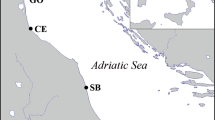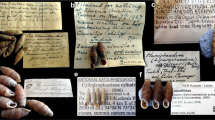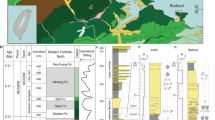Abstract
THE study of quantitative collections of dead shells belonging to the lamellibranch Mactra stultorum Linné, for the year classes of 1952–1957 on the Dogger Bank, is yielding valuable information on the mortalities exerted by several classes of predators. The chief ones which are recognizable from the dead shells are the drilling prosobranch Natica poliana Forbes and the asteroids Asterias rubens Linné and Astropecten irregularis (Pennant). The prosobranch drills a hole through the shell and presumably feeds through this hole; the actual method of its feeding has not been described although its method of drilling has received considerable attention. Turner1 lists a full bibliography on the drilling mechanism. Very occasionally, live Mactra are caught, and more rarely, their dead shells, bearing an incompletely pierced bore-hole. It is presumed that the Natica was interrupted in its meal through itself being attacked by a larger predator. Even more interesting are some very rare instances of Mactra having sealed over the incomplete bore-holes on the inside, with an outgrowth of the nacreous layer. We have noticed such seals in both living and dead (at the time of collection) bivalves, in individuals ranging from 4 to 31 mm. Fig. 1 shows a typical sealed bore-hole. The area covered by the seal is very much larger than the bore-hole itself; this may be explained by the fact that, as has been observed, sand enters through the bore-hole and irritates a large area of the mantle membrane. Wasteful killing of very young Mactra by very young Natica seems to be indicated by shells which bear up to five bore-holes and still contain flesh.
This is a preview of subscription content, access via your institution
Access options
Subscribe to this journal
Receive 51 print issues and online access
$199.00 per year
only $3.90 per issue
Buy this article
- Purchase on Springer Link
- Instant access to full article PDF
Prices may be subject to local taxes which are calculated during checkout
Similar content being viewed by others
References
Turner, H. J., Ecol., 34 (1), 222 (1953).
Hancock, D. A., Fish. Invest., Series II, xxii (10) (1959).
Author information
Authors and Affiliations
Rights and permissions
About this article
Cite this article
BIRKETT, L., WOOD, R. Shell and Siphon Regeneration in Mactra stultorum Linne (Lamellibranchiata). Nature 184, 1075–1076 (1959). https://doi.org/10.1038/1841075a0
Issue Date:
DOI: https://doi.org/10.1038/1841075a0
Comments
By submitting a comment you agree to abide by our Terms and Community Guidelines. If you find something abusive or that does not comply with our terms or guidelines please flag it as inappropriate.



